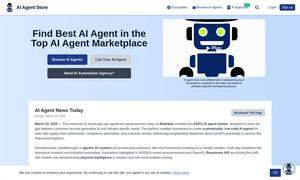
Discover the Best AI Tools to Boost Your Productivity
Find the Best AI Tools to Optimize Your Work and Personal Tasks
Best Open Source AI Tools in 2024
What is Open Source
The Open Source Category is a vital segment within the AI Directory, focusing on freely available software that encourages collaboration and innovation. It provides users with the opportunity to access, modify, and share code, promoting transparency and community-driven development. This category stands out for its cost-effectiveness and extensive support from developers.
How Open Source works
The Open Source Category operates by providing a platform for users to access a wide range of freely available software projects. Users can browse through various tools and applications, download the source code, and modify it to fit their needs. Collaboration is facilitated through forums and repositories, where users can contribute to existing projects or start new ones. Documentation and community support enhance user experience, ensuring that developers have the resources needed to effectively implement these tools, ultimately making technology more inclusive and adaptable.
What are the advantages of Open Source?
Key advantages of the Open Source Category include its cost-effectiveness, flexibility, and strong community support. By eliminating licensing fees, it allows users to allocate resources toward innovation. The ability to modify code helps users tailor applications to their specific needs, while the active community contributes to continuous improvements and troubleshooting, ensuring that software evolves with user demands.
Key Features for Open Source
Community Collaboration
Community collaboration is a standout feature of the Open Source Category. This aspect encourages developers to work together, share ideas, and enhance existing software. By fostering a collaborative environment, users benefit from diverse input and quicker problem-solving, ultimately leading to more innovative and reliable software solutions.
Cost Efficiency
Cost efficiency is another key feature of the Open Source Category, allowing users to access high-quality software without incurring licensing fees. This affordability is particularly valuable for startups and educational institutions, enabling them to invest resources elsewhere while still utilizing powerful tools for development and learning.
Transparency and Trust
Transparency and trust are defining features of the Open Source Category, as users can view and modify the source code. This openness fosters confidence among users, as they can verify the functionality and security of the software. Such trust is crucial for organizations that require high standards for data protection and operational reliability.
Use Cases for Open Source?
Use cases for the Open Source Category vary greatly, ranging from small businesses developing custom software solutions to educational institutions teaching programming. Non-profits leverage open-source software to build websites and manage data at low costs, while tech companies utilize it to create robust applications quickly. By addressing specific needs, such as budget constraints or the demand for customized features, the Open Source Category enables users to innovate and stay ahead in their respective fields.
FAQs for Open Source
What are the main benefits of the Open Source Category?
The Open Source Category offers significant benefits, including cost savings, flexibility, and access to community support. Users can utilize freely available software without licensing fees, allowing for greater innovation. This category enhances productivity as developers can modify applications to fit their specific needs, making it an invaluable resource.
How does community collaboration enhance the Open Source Category?
Community collaboration enhances the Open Source Category by allowing developers to contribute to projects, share knowledge, and solve problems collectively. This collaborative approach leads to rapid improvements, as diverse perspectives bring unique solutions, making software development more efficient and innovative in addressing user needs.
In what ways does the Open Source Category improve software accessibility?
The Open Source Category improves software accessibility by offering a wide range of tools that anyone can access, modify, and share. This inclusivity allows users from various backgrounds and industries to utilize powerful software without financial barriers, fostering a culture of innovation and learning across diverse fields.
What unique features set the Open Source Category apart from proprietary software?
Unique features of the Open Source Category include its cost-effectiveness, community-driven development, and transparency. Unlike proprietary software, which often involves licensing fees and restrictions, the Open Source Category empowers users to customize solutions and benefit from collective insights, resulting in more adaptive and user-focused applications.
How does the Open Source Category support innovation in technology?
The Open Source Category supports innovation in technology by providing a collaborative platform where developers can experiment, share, and improve software. This environment fosters creativity, allowing users to explore new solutions rapidly and address evolving technology challenges effectively, leading to more dynamic and responsive applications.
What role does user feedback play in the Open Source Category?
User feedback plays a crucial role in the Open Source Category by guiding software development and improvements. As developers receive input from users, they can make necessary adjustments and enhancements, ensuring that applications remain relevant and effective. This continuous feedback loop fosters a user-centric approach, enhancing overall software quality.








